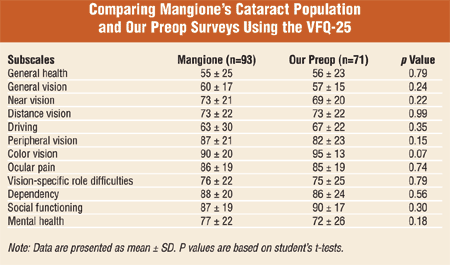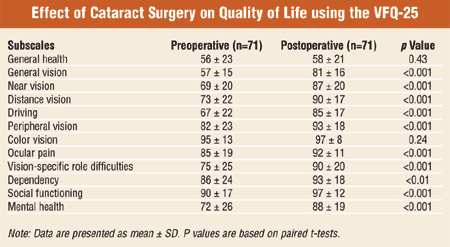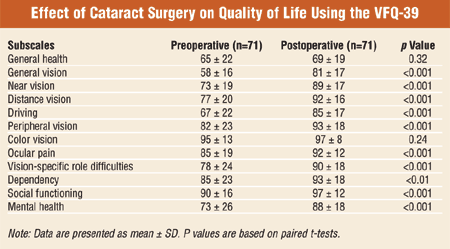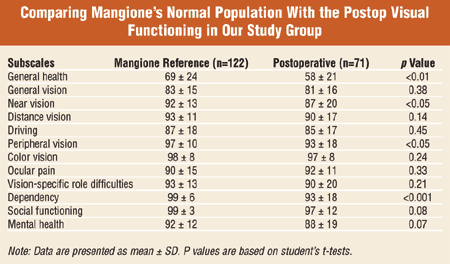Study: Comanagement results in ‘excellent’ patient outcomes
Cataract surgery has been shown to have a substantial impact on quality of life for individuals with visual compromise secondary to cataract. Techniques for cataract extraction have been revolutionized in the past decades, shortening recovery time and increasing both the surgeon’s and the patient’s expectations for visual outcome.
Multiple studies in the past decade have also shown that simple measurements of Snellen or related forms of acuity do not suffice to evaluate outcomes of cataract surgery. This deficit led to the development of several quality of life measurements, with later versions evaluating the impact that visual compromise or its rehabilitation had on quality of life. The VF-14, developed in 1993-1994, has been the most widely reported, but two recent enhancements, the VFQ-25 and VFQ-39, have also been proposed.
In an effort to explore the utility of these instruments, as well as to assess the impact of cataract surgery on visual quality in a suburban practice, we asked 100 consecutive patients scheduled to undergo cataract surgery in a suburban Pittsburgh cataract practice to fill out the VFQ-39. We also assessed the impact of comanagement on patients’ perception of outcome.
The practice of comanagement — where a portion of the postoperative care is delegated to members of the optometric community — has come under fire recently from several directions. Revicki and colleagues have evaluated this issue before and found little cause for concern (Revicki DA, Poe ML. Quality of care in cataract surgery cases experiencing post-operative complications with co-managed care. J Am Optom Assoc. 1995;66:268-273. Revicki DA, Brown RE, Adler MA. Patient outcomes with co-managed post-operative care after cataract surgery. J Clin Epidemiol. 1993;46:5-15.). However, it is clear that if one accepts that the good of the patient is the pre-eminent concern in all such decisions, it would be prudent to re-evaluate the effect of postoperative management of the cataract patient on outcomes.
Study methods
A cohort of 100 consecutive patients were enrolled in this study. Patients were included only if they had voluntarily requested comanagement arrangements with an optometrist and excluded if they were unable to comprehend the directions or unwilling to complete the study. All patients were provided with copies of the VFQ-39 during one of the preoperative visits and asked to complete the questionnaire in the office.
Dr. Mondzelewski performed small-incision phacoemulsification cataract surgery with implantation of a monofocal foldable acrylic lens on all patients. Most cases were performed under topical anesthesia. Dr. Mondzelewski saw the patients 1 day postop in his office, and the patients were again evaluated at 1 week postop. Once deemed stable, these patients were then referred, as per the patient’s request, to an outside optometrist for the duration of the postoperative period. Under no circumstances was any inducement supplied to the patient either to remain under the care of the operating surgeon or to return to the referring optometrist.
Patients were mailed copies of the same survey 8 weeks after the date of surgery and were asked to return the survey via mail. In an effort to allow comparison with earlier published studies, we included patients only if they were phakic in both eyes at the time of entry into the study. Data, therefore, allow for evaluation of the impact of first-eye surgery on quality of life.
Scoring the test results
Visual function scores were compared between Mangione’s cataract population and preoperative results of our surveyed study group using the two-sample student’s t-test. Similarly, results of Mangione’s normal reference population were compared to postoperative visual functioning of the surveyed study group using student’s t-tests. Preop and postop data were evaluated by paired t-tests, because all continuous variables followed a normal distribution as evaluated using the Kolmogorov-Smirnov test (Armitage P, Berry G, Matthews JNS. Statistical Methods in Medical Research. 4th ed. Oxford, England: Blackwell Science. 2002:359-373.).
Comparing patient groups
Seventy-one (71%) of the initially enrolled patients returned the second survey, and only these patients are included in the statistical analysis.
Results were compared with those reported by Mangione for both cataract patients and controls (Mangione CM, Lee PP, Pitts J, et al. Psychometric properties of the National Eye Institute Visual Function Questionnaire (NEI-VFQ). NEI-VFQ Field Test Investigators. Arch Ophthalmol. 1998;116:1496-1504.).
 |
We made the first comparison (see table above) between Mangione’s cataract population and the preoperative surveys in this study. For each of the 12 subscales in this table (VFQ-25), the sample sizes of 93 and 71 in the cataract reference group published by Mangione and colleagues and the preoperative group provided 80% power (ß=0.2) to detect significant differences of an effect size magnitude of 0.5 for each subscale between the groups based on two-tailed Bonferroni corrected student’s t-test. The sample sizes provide 90% power to detect slightly larger differences (i.e., effect sizes of 0.65) between the two groups. These power calculations were performed with the nQuery Advisor software program (version 5.0, Statistical Solutions, Boston).
An effect size in power analysis is defined as the mean difference divided by the estimated average standard deviation of the two groups. Effect sizes of 0.5 and 0.65 are considered small, and given that no significant differences were detected (all p>0.05) with respect to any of the subscales in the first table, one can safely conclude that the groups are essentially comparable. Therefore, the cataract patients included in this study are similar to the Mangione cataract group (Mangione CM, Lee PP, Pitts J, et al. Psychometric properties of the National Eye Institute Visual Function Questionnaire (NEI-VFQ). NEI-VFQ Field Test Investigators. Arch Ophthalmol. 1998;116:1496-1504.).
 |
 |
The two tables above indicate the effect of cataract surgery on quality of life using the VFQ-25 and VFQ-39. Both instruments revealed a significant improvement in every subscale except color vision and general health.
The table below compares Mangione’s normal population with the postoperative visual functioning of our study group (Mangione CM, Lee PP, Pitts J, et al. Psychometric properties of the National Eye Institute Visual Function Questionnaire (NEI-VFQ). NEI-VFQ Field Test Investigators. Arch Ophthalmol. 1998;116:1496-1504.).
 |
We did find differences with respect to certain subscales listed in the table comparing Mangione and colleagues’ reference group (n=122) with our postoperative group (n=71). Cataract surgery appears to have restored normal visual functioning in all categories except general health, near vision, peripheral vision and dependency. Power was excellent to detect even small mean differences, as shown in the table (general health, near vision, peripheral vision, dependency). Again, we are referring to small differences of an effect size magnitude of 0.5.
For example, for general health, the mean difference between the two groups was 11 points, and the common or pooled standard deviation was (24+21)/2 or approximately 22 points. Hence, the effect size is 11/22=0.5. Clearly, with sample sizes of 122 and 71, there was sufficient power for detecting “small,” but clinically meaningful differences.
Previous results validated
Our study appears to validate, in part, Mangione’s VFQ-25 and VFQ-39 inasmuch as cataract surgery resulted in detectable measurable improvement in visual functioning, a finding noted in multiple prior studies. The population studied here was not different from Mangione’s cataract population. Most interestingly, cataract surgery restored normal visual functioning in all except two vision-based categories (near vision and peripheral vision). It must be noted that this comparison was between an age group that has undergone cataract surgery with a younger, otherwise healthy population This may account for these differences as well as the failure to improve general health and dependency.
A secondary outcome of this study was the impact of comanagement on the outcome of surgical intervention for cataract surgery. It was not possible in this study to compare a non-comanaged group with the study population. This will be undertaken in future work. However, given that the intervention performed here restored normal visual functioning in nearly all categories, it is difficult to imagine that greater improvement will be seen in patients who are not comanaged. Therefore, it is a reasonable conclusion that comanagement does not lessen the quality of the outcome after cataract surgery, and in fact seems to result in excellent patient outcomes.
For Your Information:
- Evan B. Dreyer, MD, and James P. Mondzelewski, MD, are staff members at Glaucoma and Cataract Consultants in Pittsburgh and can be reached at Glaucoma-Cataract Consultants, 1050 Bower Hill Rd., Suite 104, Pittsburgh, PA 15243; (412) 572-6121; fax: (412) 571-1327; e-mail: dreyer@fastmail.fm.
- David Zurakowski, PhD, is from the departments of orthopaedic surgery and biostatistics, Children’s Hospital, Harvard Medical School, Boston.
